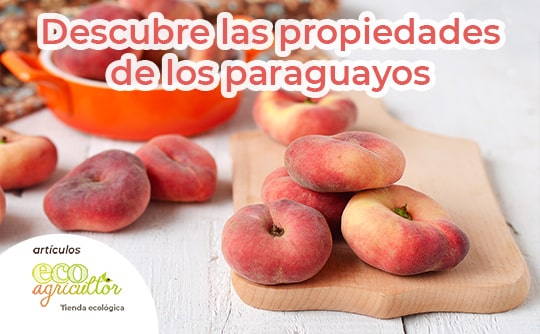Paraguayan, one of the fruits that take care of us during the summer. Have you tried this flat peach yet?

What is Paraguayan? The Paraguayan ( Prunus persica (L.) Batasch var. Platycarpa LH Bailey), like the nectarine , are a variation of the peach tree.
Paraguayans, along with peaches and nectarines, are included among the fruits of the summer season . The Paraguayan is a fruit with reddish-yellow skin and sweet and juicy white or yellow flesh.
The fruit of the platycarpa variety , although strictly speaking it is a cultivar, is known as Paraguayan, Paraguayan peach or flat peach , in English it is also called donut peach or flat peach due to its characteristic flattened disc shape.
In Spain, the cultivation of the Paraguayan or flat peach has grown, especially since the late 1980s, both to supply exports and to satisfy the growing demand in the national market.
Although Spain is currently the main exporter of Paraguayan or flat peach worldwide, this cultivar is also in great demand for export to France, and is produced to meet the demand of the national market in many countries with a subtropical climate.
.
Nutritional value of the Paraguayan or flat peach
This drupa, tasty and velvety skin that is especially consumed in summer, plus a powerful flavor provides a good amount of vitamins , especially vitamin A and C, but also contains minor amounts of vitamins B3, B9 and vitamin E .
According to the varieties -of fruits of different genetic populations-, the flat peach has:
- Energy value: 53.17 Kcal per 100g
- Fat content: 0.21%
- Protein: 0.68%
- Dietary fiber: 1.78%
- Carbohydrates: 12.14%
- Minerals: especially sodium, potassium, and iron, along with calcium, iodine, zinc, and selenium.
The nutritional profile varies with crossing, as well as with climatic, soil and management conditions, however, most studies with laboratory samples agree that those with white pulp show greater antioxidant power .
Within the organoleptic qualities of flat peaches, it is known that the most important carbohydrate levels (sucrose, glucose and fructose), which are those that contribute to the flavor and texture of the fruit , increase in the last phase of growth. That is why it is important that they are harvested at their optimum point of maturity and never before.

What is Paraguayan good for?
This fruit, like other peach varieties, has great potential as a functional food and is recommended to prevent weight gain and obesity, as it is very low in fat and provides a good energy and fiber intake.
However, the flat or Paraguayan peach is mainly a rich source of phytochemicals with antioxidant activity , especially phenols and carotenoids, which inhibit the oxidation process as scavengers of free radicals involved in most degenerative diseases .
The main constituent, similar to that contained in peaches and nectarines, are β-carotene, β-cryptosanthin and lutein, which are very effective against free radicals, as oxygen suppressants and which function as antioxidants that break chains protecting cells against radical attack.
For its part, the phenolic profile shows that the most abundant compound is chlorogenic acid, followed by gallic acid, protocatechual acid, ptrotocatechualdehyde, p-cumaric acid and ferulic acid.
Antioxidant activity results from a complex interaction between these phytochemicals that produce synergistic responses and, together with the contribution of fiber, water and vitamins, has multiple positive impacts on health:
- Strengthen the immune system
- Control cholesterol
- Regulate the nervous system
- Maintain skin health
- Strengthen bones and teeth
The latter is particularly due to the contribution of minerals that play a prominent role in this fruit, since iron helps metabolize proteins and the production of hemoglobin, which has a good effect on the health of the circulatory system .
The vitamin C , one of the most important compounds in fruits, is a micronutrient that helps keep the skin, gums and vessels healthy blood , in addition to participating in the formation of collagen and absorption of iron from plant, reducing cholesterol and boosting the immune system.
It is harvested between May and October, so it is predominantly a summer fruit, ideal to include in smoothies and desserts, as well as to take it natural directly. Take it on an excursion, to the pool or to the beach to nourish, hydrate and refresh yourself.
Bibliography
- «LXXXVIL Rosaceae – Amygdaloideae», Iberian Flora Vascular plants of the Iberian Peninsula and Balearic Islands, Royal Botanical Garden, Higher Council for Scientific Research.
- «Selection of new peach varieties [ Prunus persica (L.) Batsch] based on agronomic, morphological, quality and fruit conservation characteristics», Gemma Reig Córdoba. University of Lleida. 2013
- «Prunus persica var. plantycarpa (Tabacchiera Peach): Bioactive compounds and antioxidant activity of pulp, peel and seed ethanolic extracts ”, Monica R. Loizzo, Deborah Pacetti, Paolo Lucci, Oscar Núñez, Francesco Menichini, Natale Giuseppe Frega and Rosa Tundis. Department of Pharmacy, Health and Nutritional Sciences, University of Calabria. 2015.
- «Agronomic and fruit quality study of the peach tree [ persica (L.) Batsch] in different breeding populations for the selection of new cultivars», Celia M. Cantin Mardones. 2009

![Photo of Chanchito de Tierra: [Characteristics, Detection, Effects and Treatment]](https://www.complete-gardening.com/wp-content/uploads/2021/06/Que-es-el-chanchito-de-tierra-390x220.jpg)

![Photo of How to Plant Passion Flower in Your Garden: [Complete Guide]](https://www.complete-gardening.com/wp-content/uploads/2022/08/how-to-plant-passion-flower-in-your-garden-complete-guide-390x220.jpg)
![Photo of How to Plant Vines and Get Top Quality Grapes (or Wine): [Complete Guide]](https://www.complete-gardening.com/wp-content/uploads/2022/08/how-to-plant-vines-and-get-top-quality-grapes-or-wine-complete-guide-390x220.jpg)